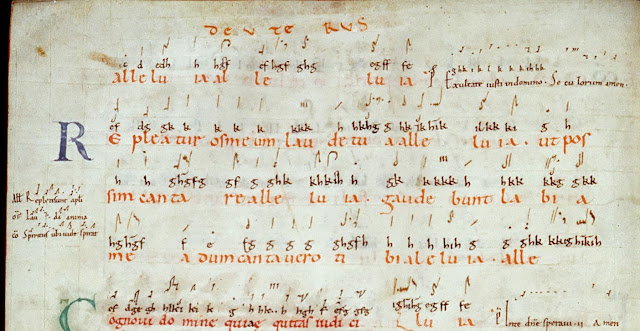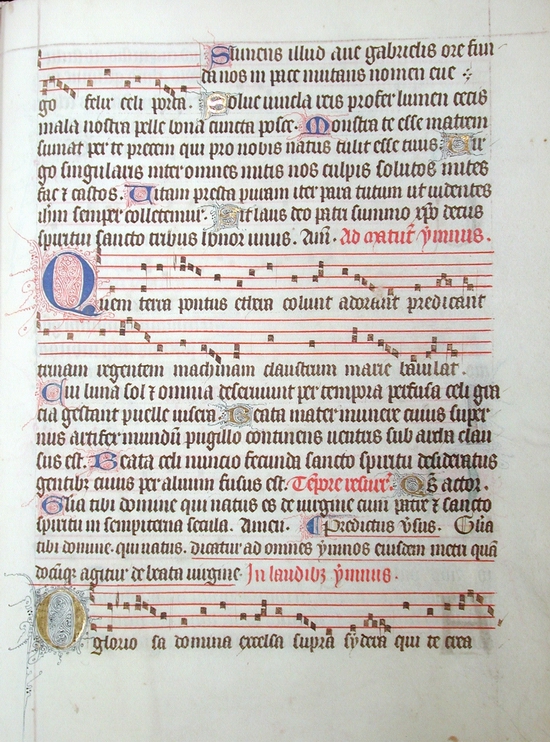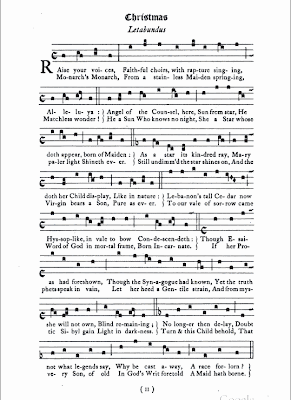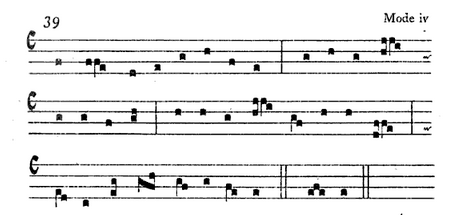From Hymn melodies for the whole year from the Sarum Service-books:
Here are the chant scores for #63 and #64 from Hymn Melodies:
These melodies are both used for other Marian feasts: you'll hear one or both at Conception (January 8); Purification (Feb. 2); Assumption (August 15); and Nativity (September 8). Tune #63 is also used for O Nata Lux on Transfiguration.
It's hard to find even the words for these St. Anne hymns, though - let alone the music. So I'll offer audio files of the melodies as used for other hymns.
Here's an mp3 of the cantor from LLPB singing melody #63 above; the hymn text is "The God Whom Earth and Sea and Sky" (the English version of Quem terra, pontus, etheraposted at Oremus Hymnal). That hymn is sung at Matins of Assumption.
Hymn melody #64, used for Ave! Mater Anna, is well-known as the tune for Ave Maris Stella, sung on the September 8 Feast of the Nativity of the Blessed Virgin Mary (as well as at other times; the video below has labeled it for Easter).
Here's a (very faint) recording of the same hymn, sung by the Benedictines of Brazil.
It's a nice sort of doublet, having the same hymn tune used for both mother and daughter, and having the same opening structure. Ave! Mater Anna calls naturally to mind Ave Maris Stella.
I'm wondering if this was precisely done by design in Sarum - in part because Giovanni Vianini sings what I assume is more or less this same hymn as Gaude, Mater Anna. He sings it to a different melody, though:
Here are the Latin words he's using (more or less); they come from Hymni inediti: Liturgische Hymnen des Mittelalters aus Handschriften und Wiegendrucken (tr: "Hymni Inediti: liturgical hymns of the Middle Ages from manuscripts and incunabula") at Google books:
There are quite a few hymns for St. Anne at that Google book, but this is the only one that's included on the above Sarum list - and unfortunately at the moment I can't find the words, even in Latin, for either In Anne puerperio or Felix Anna pre aliis. I believe the former translates as "While Anne in childbirth...." and the latter as "Happy Anna, before all others...." I've looked for hymns that might be related to those ideas, but so far have come up with nothing. Very obscure, these!
But, as always: if I find anything, I'll certainly come back to post it. There are some very nice lyrics to some of the hymns in the book; check them out.
Keep in mind, about St. St. Anne, that:
Clearly, Mary had a mother and father - and perhaps they were named Anne and Joachim. It's certainly OK with me that they're included in the calendar, even if they're not included in the Scriptures by name; as Jesus' Grandma and Grandpa, they remind us in a lovely incarnational way about grandparents everywhere. I can't think of anything better, myself.
Current calendars, both Roman Catholic and Anglican, include Joachim for this day as well; the 1979 BCP calls this the Feast of the Parents of the Blessed Virgin Mary. But the Sarum calendar, it seems, celebrated Anne by herself.
Here are the current readings and the collect for the day, from Satucket:
On the Feast of S. Anne, Mother of the B. V. Mary (July 26):Mattins: In Anne puerperio ... ... ... ... 63
Lauds: Felix Anna pre aliis ... ... ... ... 63
2nd Evensong: Ave! mater Anna ... ... ... ... 64
Here are the chant scores for #63 and #64 from Hymn Melodies:
These melodies are both used for other Marian feasts: you'll hear one or both at Conception (January 8); Purification (Feb. 2); Assumption (August 15); and Nativity (September 8). Tune #63 is also used for O Nata Lux on Transfiguration.
It's hard to find even the words for these St. Anne hymns, though - let alone the music. So I'll offer audio files of the melodies as used for other hymns.
Here's an mp3 of the cantor from LLPB singing melody #63 above; the hymn text is "The God Whom Earth and Sea and Sky" (the English version of Quem terra, pontus, etheraposted at Oremus Hymnal). That hymn is sung at Matins of Assumption.
Hymn melody #64, used for Ave! Mater Anna, is well-known as the tune for Ave Maris Stella, sung on the September 8 Feast of the Nativity of the Blessed Virgin Mary (as well as at other times; the video below has labeled it for Easter).
Here's a (very faint) recording of the same hymn, sung by the Benedictines of Brazil.
It's a nice sort of doublet, having the same hymn tune used for both mother and daughter, and having the same opening structure. Ave! Mater Anna calls naturally to mind Ave Maris Stella.
I'm wondering if this was precisely done by design in Sarum - in part because Giovanni Vianini sings what I assume is more or less this same hymn as Gaude, Mater Anna. He sings it to a different melody, though:
Here are the Latin words he's using (more or less); they come from Hymni inediti: Liturgische Hymnen des Mittelalters aus Handschriften und Wiegendrucken (tr: "Hymni Inediti: liturgical hymns of the Middle Ages from manuscripts and incunabula") at Google books:
Gaude, mater Anna,
gaude mater sancta,
cum sis Dei facta
genetrix avia.
Plaude tali natae
virgini Mariae;
eius genitore
Ioachim congaude
in hac nostra terra
primo benedicta,
quae fuit in Eva
quondam maledicta.
Ergo sume laudes
quas damus ovantes;
nos ab omni sorde
tua prece terge.
Sit laus Deo Patri,
summo Christo decus,
Spiritui Sancto
honor, tribus unus.
Loose English translation, with the help of Google Translate:
Rejoice, mother Anne,
Rejoice holy mother,
God made you
mother and grandmother.
Applaud such a daughter
Mary the Virgin;
Her father Joachim
Also rejoices
in this our country,
She is blessed first,
Which was in Eve
once cursed.
So receive our praise
which we exultant give;
save us from all stain
by your prayer.
Praise be to God the Father,
All praise to Christ and honor,
And to the Holy Spirit
honor, to the Three-in-One.
There are quite a few hymns for St. Anne at that Google book, but this is the only one that's included on the above Sarum list - and unfortunately at the moment I can't find the words, even in Latin, for either In Anne puerperio or Felix Anna pre aliis. I believe the former translates as "While Anne in childbirth...." and the latter as "Happy Anna, before all others...." I've looked for hymns that might be related to those ideas, but so far have come up with nothing. Very obscure, these!
But, as always: if I find anything, I'll certainly come back to post it. There are some very nice lyrics to some of the hymns in the book; check them out.
Keep in mind, about St. St. Anne, that:
Saint Anne (also known as Ann or Anna, from Hebrew Hannahחַנָּה, meaning "favor" or "grace") of David's house and line, was the mother of the Virgin Mary and grandmother of Jesus Christ, according to Christian and Islamic tradition. Mary's mother is not named in the canonical gospels, nor in the Qur'an. Anne's name and that of her husband Joachim come only from New Testament apocrypha, of which the Protoevangelium of James (written perhaps around 150) seems to be the earliest that mentions them.
Clearly, Mary had a mother and father - and perhaps they were named Anne and Joachim. It's certainly OK with me that they're included in the calendar, even if they're not included in the Scriptures by name; as Jesus' Grandma and Grandpa, they remind us in a lovely incarnational way about grandparents everywhere. I can't think of anything better, myself.
Current calendars, both Roman Catholic and Anglican, include Joachim for this day as well; the 1979 BCP calls this the Feast of the Parents of the Blessed Virgin Mary. But the Sarum calendar, it seems, celebrated Anne by herself.
Here are the current readings and the collect for the day, from Satucket:
Readings:Psalm 132:11-19
Genesis 17:1-8
1 Thessalonians 1:1-5
Luke 1:26-33
Collect (contemporary language):
Almighty God, heavenly Father, we remember in thanksgiving this day the parents of the Blessed Virgin Mary; and we pray that we all may be made one in the heavenly family of your Son Jesus Christ our Lord; who with you and the Holy Spirit lives and reigns, one God, for ever and ever.
Meanwhile, here's Bach's Fugue in E-flat (BWV 552) - the "St. Anne fugue." This site says that:
There are some nice icons and other works of the mother of the Mother of God! This one is a detail, labeled "Faras Saint Anne"; Wikipedia says it's now in the National Museum of Warsaw, but originally Coptic, from the 8th century, and tempera on plaster:
Here's a Greek one that Wikipedia labeles as "Angelos Akotanos - Saint Anne with the Virgin," from the 15th Century:
Here's a nice one, labeled "German, 15th century. Anne holds Mary and Christ." It seems to be a plaster representation located in the Limburg Cathedral.
Those of us in the English-speaking world have dubbed it “St. Anne” after a popular English hymn of Bach’s day (usually set with the text “Oh God Our Help in Ages Past”). “St. Anne” is the name of a church in the Soho section of London, where the hymn was written. It’s not known if Bach had actually heard this tune, or if the similarity to his opening fugue subject is purely coincidental.
There are some nice icons and other works of the mother of the Mother of God! This one is a detail, labeled "Faras Saint Anne"; Wikipedia says it's now in the National Museum of Warsaw, but originally Coptic, from the 8th century, and tempera on plaster:
Here's a Greek one that Wikipedia labeles as "Angelos Akotanos - Saint Anne with the Virgin," from the 15th Century:
Here's a nice one, labeled "German, 15th century. Anne holds Mary and Christ." It seems to be a plaster representation located in the Limburg Cathedral.


.jpg)

















































